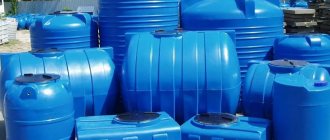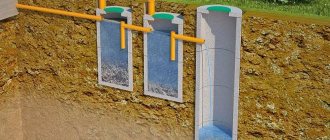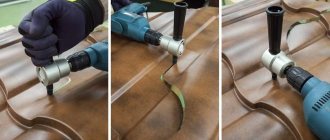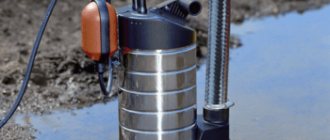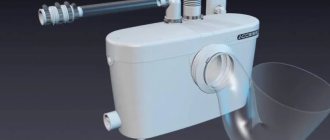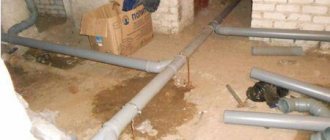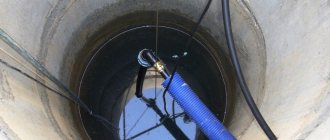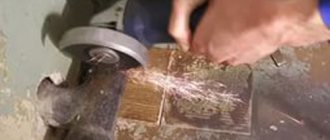It happens that the layout of a country house involves installing a bathroom in the basement or basement, or simply at a considerable distance from the sewer riser. In this case, how can we organize the disposal of wastewater and, moreover, do without large-scale work on the reconstruction of the sewerage system?
If plumbing fixtures are located below the entrance to the sewer riser, discharge of dirty water by gravity is impossible. Usually the problem is solved by constructing an intermediate storage tank, essentially a mini-septic tank, the effluent from which must be directed to the main septic tank located at a standard distance from the house. Only special pumps can provide this - drainage and fecal units of submersible, semi-submersible or surface type. It is clear that it is not always possible to build a storage pit under a house. It is for such cases that the market offers forced sewage pumps,
installed indoors directly behind the toilet (they are also called toilet attachments or simply toilet attachments). In addition to devices designed to work with traditional floor-mounted toilets, models of reduced depth (from 120 mm) are produced, designed to serve wall-hung and installed toilets (the so-called hidden installation systems).
Forced sewage pumps are compact devices equipped with a grinder
and designed specifically for transporting liquids with “heavy” contaminants (fecal matter and toilet paper).
Different models of pumps allow connecting to them either only a toilet, or one or several additional plumbing fixtures
- a bidet, a urinal, sinks, a shower. Depending on the possible number of connections, the pump body has a corresponding number of inlet pipes with a diameter of 40 mm (standard toilet inlet is 100 mm).
Manufacturers and models
Not many companies produce individual sewerage installations. However, the price range is quite wide. Traditionally, European manufacturers are distinguished by good quality, but high prices. No one will be surprised if we say that Chinese sewage pumps cost less, but their quality is worse. In general, the choice, as usual, is expensive and high quality, or cheaper and...
Forced sewerage installations Grundfos (Grundfos) - Sololift (Sololift)
The well-known manufacturer of plumbing fixtures Grundfos produces Sololift pumps for forced sewerage. At the moment, a modified Sololift2 line has been launched. There are no moving parts in contact with drains. The exception is the chopper, but its drive is also “dry”. This makes repairs less of a hassle. There are several Sololift models for different cases:
Sololift sewer pumps are not the cheapest equipment, but they work reliably and meet the stated characteristics. The company also supports warranty repairs.
Pumps for toilets, bathrooms, kitchens and technical rooms SFA
This company specializes in the production of sanitary pumps. There are several lines to solve different problems and connect various devices:
SFA products work reliably and cost slightly less than Grundfus. You can choose a model for any combination of plumbing fixtures. Overall, the SFA sewage pump is a good option. Equipment installation is standard - place it in any convenient place. There is only one limitation - it is better for the outlet pipeline to start from a vertical section, if there is one on your route. If this is not possible, the length of the horizontal section should be no more than 30 cm.
The height of the vertical section is calculated taking into account that the horizontal section must have a slope towards the inlet of at least 1% (1 cm per 1 meter of pipe).
CompactLift fecal pumps from Aquatik
Toilet pumps Compact Lift are produced by the Chinese company Aquatic. This is a more budget-friendly option for individual sewer installations. They have a low noise level.
At the moment there are only three modifications:
Aquatik provides a warranty on its pumps for bathrooms and toilets for 1 year from the date of sale. Failure to operate (presence of fibrous inclusions in drains) may result in refusal of warranty repair.
Willo sewage pumps
The German company Willo is known for producing reliable devices. Toilet pumps are no exception. Good quality plastic, thick tank walls, reliable pump. The following models are available:
The Willo range of sewer pumping units allows you to solve any problem when it comes to equipping bathrooms and toilet rooms in private homes. For commercial or more intensive use, Willo has other solutions.
Pressure sewage pumps STP (Jemix)
These custom sewer installations are manufactured in China. The price category is average. Reviews, as usual, are different - some are completely satisfied, others categorically dislike it.
So, here are the sewerage pumps Jemix offers:
It differs from those described above in its increased power - some models raise drains by 9 meters. Most of the sewerage pressure pumps described above can lift wastewater up to 4-5 meters. So this is where the Jamicks win. In this parameter they have only one competitor - Sololift Grundfos with its lifting height of 8 meters. But its price category is completely different (as is its quality, for that matter).
Device and purpose
A pump with a grinder is a surface sewer pumping installation that allows you to organize the removal of wastewater where it is not possible to do this using a gravity system. This is a small plastic container with a powerful built-in pump that pumps waste into the sewer. The movement of drains can be both vertical and horizontal. There are installations with a grinder that can be connected to toilets, and there are those without a grinder - for “gray” waste from sinks, showers, bidets, etc.
Application area
A sewer pump is used in cases where it is impossible to create a gravity sewer system. In most cases, when a plumbing fixture, washing machine or dishwasher is installed below the entrance to the sewer. This is why forced sewage pumps were invented. This solution allows you to move bathrooms and technical rooms to basements or semi-basements.
A pump with a grinder is also installed if it is decided to build a bathroom after the renovation is completed and the sewerage system is not connected to the place where the plumbing is supposed to be installed. In this case, the installed equipment is connected to a compact sewage pump, and it is connected to the sewer. What is the difference? In the following:
- the diameter of the outlet pipes for the sewer pump is much smaller than for the gravity system (28-40 mm);
- drains can rise up to a height of up to 9 meters;
- horizontal wastewater disposal is possible up to 100 meters (requires a minimum slope of 1-4%).
All this allows you to organize a connection to an existing sewer system almost anywhere at minimal cost.
Design and principle of operation
The sewage pump consists of a plastic storage container and a pump. Some models that can be connected to a toilet have a grinder. The filling level is controlled by a sensor. When it is triggered, the grinder and pump are turned on, and wastewater is pumped into the sewer system. The shutdown is controlled by a second sensor - it turns off the power when the wastewater level drops below a certain level. This is a simplified algorithm for the operation of pressure sewerage.
There are sewage pumping stations designed to connect devices of various types and quantities. The simplest one is designed to connect one or two devices, the most productive one has three additional pipes (and one main one). Accordingly, the container has one or more inlet holes (depending on the model) and one outlet hole. Pipes coming from the plumbing are connected to the inlets, and the outlet is connected to the sewer.
For pumping out high-temperature wastewater from washing machines, dishwashers, and bathtubs, there are special models made of heat-resistant materials. A conventional sewage pump cannot cope with such a load. Therefore, to connect such equipment you need to look for certain models.
Which is better - submersible or surface?
With the same output pressure, a submersible sewage pump consumes less power than its external self-priming counterpart. The former simply does not have to waste energy on sucking wastewater through the outlet from the bottom of the container to the working chamber. All the power of the electric motor is spent on creating pressure in the pressure line.
A pump completely immersed in wastewater produces an order of magnitude less noise than one installed on the surface. Water absorbs most of the sounds produced by the electric motor and the rotating working elements of the pump.
Surface equipment is noisier than equipment immersed in a sewer tank, which is cooled by the liquid around it
In terms of ease of use, the palm can be given to the surface model, but only if it is compact and portable. Plus, the correctness of its operation can be monitored simply by the noise it makes. If the electric motor does not operate correctly, extraneous sounds appear, immediately indicating problems.
With all other parameters and additional equipment being equal, a surface pumping station will almost always cost less than a submersible sewage pump. Of course, a lot depends on the manufacturer and competition in a particular region.
However, equipment immersed in sewage is, by definition, more technologically advanced and more complex, which determines its higher price.
Use of forced sewerage
Features of drainage of dishwashers and washing machines
Everyone knows that modern automatic machines (washing or dishwashing) must be connected to the sewer system in order to remove contaminated used water. But in small city apartments there is hardly room to install these assistants in the sewerage area; this is typical for both the bathroom and the kitchen.
And in large cottages, you want to hide the units in the basement rooms, which often serve as the utility floor. In both cases, there is a solution if forced sewage pumps are used. The essence of the solution is as follows:
- Here you will need to place a special sewerage installation equipped with a water collection tank and a built-in pump.
- The drains gradually fill the container in which the float switch operates. When their volume reaches a certain value, a pump is turned on, pumping contaminated water into the sewer.
- Such forced sewerage is small in size and is installed in an apartment or house in close proximity to the equipment that produces wastewater.
- It is equipped with a carbon filter that prevents unpleasant sewage odors from entering the room.
A reliable and efficient system does not require specific maintenance measures; you only need to periodically clean and rinse the tank.
Reconstruction or relocation of a bathroom
As mentioned above, moving a bathroom to another, more convenient place can be done in two ways:
- carry out redevelopment of the apartment, carrying out a major overhaul of the premises;
- install forced pumps for pressure sewerage.
The second option is more affordable and faster. But at the same time, you need to purchase a sanitary pump that meets special requirements. After all, he will have to work with aggressive environments.
Features of operation
The main condition for the full operation of a forced sewer pump is the presence of a centralized water supply .
The artificial sewerage mechanism is easy to maintain . From time to time, the container for collecting waste waste needs to be sanitized. To do this, it is enough to fill the tank with “Belizna” or a specially designed product or liquid for cleaning pipes, which effectively dissolves deposits on pipes and walls.
At the same time , you should refrain from using organic products that can render rubber seals and plastic water pipes unusable.
If the sanitary pump is used in unheated premises, at the beginning of the winter season .
Types of forced fecal pumps
- Equipment for pumping gray wastewater at high temperatures without including fecal waste. In this case, the pump does not have a grinder and is capable of transporting hot, more or less clean water from a washing machine or dishwasher, as well as from a kitchen sink. The dimensions of the installation are quite compact, which allows you to mount the sololift directly in the kitchen cabinet under the sink or even on the wall. The pump works with water whose temperature does not exceed 90 degrees. Such equipment is relevant for installation if the kitchen or laundry room is located far from the central riser.
- Model of a pump for hot wastewater with a grinder. This device is designed for pumping wastewater, the temperature of which can reach 95 degrees. Thanks to the powerful knife built into the mechanism, the sololift processes all fecal and hygienic waste, including small items. Thus, the installation of such a forced sewage system is relevant in almost any of the plumbing or utility rooms of a private house or apartment. But the cost of such a sololift is several times higher than that of the previous model.
- Pump with grinder for cold drains in the house. Most often, this unit is used for installation behind the toilet. The shredder's sharp blades do an excellent job of removing any fecal waste. Thus, the equipment can operate uninterruptedly, provided that the temperature of the wastewater does not exceed 40 degrees. Included with this pump is a special coupling for a high-quality connection of the forced sewage system with the toilet.
Types of Domestic Sewage Drains
To make internal sewerage in the basement of a private house effective, you need to know about the characteristics and volumes of discharged liquids
To make the internal sewage system in the basement of a private house effective, while avoiding the installation of unnecessary pumps in this situation, you need to know about the characteristics and volumes of discharged liquids. They are usually divided into two types:
- moderately polluted;
- heavily polluted.
Significantly contaminated liquid household waste includes the contents of toilet bowls. They contain solid and fibrous particles, so to remove them upstairs from the basement you will need special pumps equipped with the function of grinding solids and greater throughput.
All other household liquids that can be discharged from swimming pools, showers, washing machines and other plumbing and household appliances located in the basement are classified as moderately contaminated. To transport them to the level of the main sewer pipe, conventional pumps with a storage tank are used.
Design and principle of operation of forced sewerage
To understand how the drainage forcing system works, you need to know its structure. Thus, the forced sewage system consists of a capacious tank, inside of which there are:
- Special grinder attachment;
- Carbon filter;
- Float switch;
- Pumping unit.
Sololift works this way:
- The wastewater enters the storage tank until it is filled to a certain level;
- At this moment, the float switch gives a signal to the pump, and it begins its work;
- The grinder is also turned on here, which turns the wastewater into a porridge-like liquid;
- The pump pushes recycled water into the collector and then into the central drain.
Separated sewage system
Separate removal from the basement of fecal and relatively clean liquid is advisable in case of large volumes of the latter
Separate drainage of fecal and relatively clean liquid from the basement is advisable in the case of large volumes of the latter. If there are many water intake points installed in the basement floor, giving a large total volume of water disposal, two schemes for pumping waste water are possible. The first involves the installation of a small fecal pumping station for the toilet (sololift) and a separate pump for slightly polluted water. A similar scheme is shown in the photo
The second scheme is rational when there is a swimming pool inside the basement. It is more advisable to service it with a separate pump, while connecting the remaining points to a low-power pumping station capable of removing fecal contamination.
Sololift installation
When purchasing a forced sewer system, please note that different sololifts are designed for different plumbing fixtures. Manufacturers produce them separately for:
Manufacturers produce them separately for:
- toilet;
- shells;
- baths;
- shower cabin.
Pro tip:
The diameter of the sololift inlet must correspond to the diameter of the outlet of the sewer drain pipe. Otherwise the installation will not be correct.
Installation of forced sewerage can be done with your own hands, calling on the help of specialists only to connect it to the electrical network. Forced drainage is installed according to the instructions.
The optimal option is considered to be such an arrangement of the pipeline in which its beginning has a strictly vertical position, and then it runs horizontally, with some slope. The main parameters for horizontal and vertical sections of the pipeline, as well as the slope value, are prescribed in the technical data sheet of the sololift or in the installation instructions.
The figure clearly shows the inverse relationship between the length of the vertical riser and the dimensions of the horizontal riser. If the vertical section of the pipeline rises to a height of no more than 1 m, then the length of the horizontal pipe can be 50 m. But if the height of the pipeline is 4 m, its horizontal length cannot exceed 10 m.
As an example, we present a fragment of instructions for forced sewerage:
Insert the drain pipe from the toilet or siphon into the inlet device. Lead the opposite part of the sololift to the sewer riser. Connect the sololift to the electrical network through an outlet or directly into the panel
It is important that the system is equipped with a residual current device (RCD).
Thus, it is quite simple to carry out independent installation if you have at least minor skills. In other cases, it is better to entrust it to specialists. Otherwise, forced sewer systems have virtually no restrictions on their use and will be an excellent assistant in housing redevelopment.
Sometimes it happens that in the purchased apartment the plumbing and utility rooms are not located exactly as the new owner would like in accordance with the interesting interior design. Or maybe it’s just that in a private house there is a need to re-equip the collector in order to supply several new household appliances. In these and other cases, there may be a problem with drainage into the central riser. Forced sewerage (sololift) will help solve the issue without maximum waste of finances, time and effort.
Such a device is a powerful fecal pump with a built-in mechanism for grinding fecal waste and its further transportation through sewer pipes.
It is important to use such a forced pump in the following cases:
- Redevelopment of an apartment or private house with a change in the location of the kitchen or utility room (laundry room);
- The need to install household appliances that work with water in a house or apartment in non-standard places;
- Installation and arrangement of a laundry room or bathroom in the basement, where the sewer pipeline will pass below the level of the central drain;
- Forced transportation of wastewater from the collection well of a private house to a septic tank if the length of the pipeline is too long.
- Thus, with the use of such a device, it is possible to avoid complex, dirty and expensive repairs to remodel the building;
- The compactness of the device allows you to install it directly behind or under a plumbing fixture, hiding it from prying eyes and without disturbing the picture of the interior;
- The power of the sololift allows you to lift wastewater into the drain to a height of 5 to 7 meters, and transport it to the storage tank at a horizontal distance of up to 100 meters.
- The performance and quality of the grinding mechanism makes it possible to transform fecal wastewater containing garbage into water with a mushy consistency, which makes it possible to transport it to the drain through small diameter pipes (18-40 mm);
- Convenient location of sewer pipes indoors due to their small cross-section;
- The presence of a special carbon filter in the installation, which prevents unpleasant sewer odors from entering the room;
- Relatively low noise level of the installation, which makes the use of a sololift as comfortable as possible for all household members.
Operating principle
Thanks to technological progress, mechanisms called sololifts have appeared, which crush masses of waste and forcefully transport them through pipes of smaller diameter. As a result, users have the opportunity to “move” plumbing fixtures away from the riser and even place them below the discharge level into the external sewer system, where wastewater cannot leave the basement by gravity. The movement of waste is carried out forcibly, for which special electric fecal pumps are used - sololifts.
Sewage pumps Sololift Grundfos models and their characteristics
The most popular units used for forced drainage of wastewater into sewers are Grundfos
. The entire line includes five models, each of which has its own technical features.
- This model is not equipped with a cutting mechanism, and therefore is intended for the removal of wastewater that does not contain solid fractions. Can be connected to a shower cabin, washbasin, bathtub or bidet. The most compact and economical model
from the entire Grundfos Sololift range.
SOLOLIFT2 C-3
This model also does not have a grinder, so it cannot be connected to the toilet. A distinctive feature of Sololift2 C-3 is its ability to withstand high temperatures
, and therefore such a pump can be used to organize a forced sewage system in the kitchen - to remove waste from the kitchen sink and dishwasher.
SOLOLIFT2 WC-3 This model can also be built into a forced sewage system for toilets, as it has a built-in grinder. This pump differs from the previous model in that it has 3 input connections, and therefore it can be connected to several plumbing fixtures at the same time.
Thanks to their performance and power, sewage pumps of this type can meet the needs of a small family cafe or restaurant. In addition, they are capable of pumping wastewater through small diameter pipelines (from 32 to 50 mm).
Technical specifications:
- Raising drains by 7 m in height and 70 m horizontally.
- Possibility of working with wastewater at temperatures up to + 75 degrees (for a short period of time). Operating temperature: 35 degrees.
This sewer pump for a kitchen sink costs from 25 thousand rubles.
SFA Saniaccess Pump
The pump is suitable for kitchen and bathroom equipment anywhere, regardless of the location of the stationary sewer system.
Technical specifications:
- Maximum wastewater temperature: up to +75 degrees (short-term).
- Feed height: up to 5 m (horizontally – up to 50 m).
- There is no grinding mechanism.
- Price - 18,500 rubles.
Unipump Sanivort 250
Thanks to the high quality of assembly and reliability of components, the pump is durable and practical. Suitable for use in an apartment or country house.
Its distinctive features:
- The pump housing is made of high quality plastic, easy to clean.
- The presence of two inputs, one of which, with a diameter of 40 mm, is suitable for connecting a shower or sink.
- The presence of a check valve that prevents wastewater from mixing with clean water.
- Thermal protection function of the pump motor.
- The presence of a built-in pressure sensor that allows the device to automatically turn off and turn on if necessary.
Technical specifications:
Capacity: 80 l per minute. Dimensions: 172 x 158 x 339 mm. Maximum head: 5 m vertically and 40 m horizontally. The price of the pump will be about 10,500 rubles.
The typical location of a sewer riser in an apartment often turns out to be not the most convenient for its owners, because the placement of the kitchen and bathroom depends on this; forced sewerage is a way to get rid of this inconvenience. With its help, you can not only organize the disposal of wastewater, bypassing the need for redevelopment (and associated capital construction work), but also install plumbing fixtures in the basement of a private house (when the plumbing is located below the riser, and the drains cannot be discharged by gravity). You can learn how to create such a system from this article.
How does this type of sewer work?
Forced sewerage equipment is most often installed in country houses. Otherwise the system is called sololift.
The equipment for this type of sewage system is a pump with a grinder, which has compact dimensions and is hidden in additional plumbing or in the toilet tank.
The wastewater entering the forced sewage device is pumped out and ground by a grinder. After this, the sewage enters the septic tank or the central sewer pipeline.
The pump with the chopper has high power parameters. This allows him to cope with a wide variety of human waste and remove it in any direction: vertically - five to seven meters, horizontally - one hundred meters
. A vertical outlet is necessary if all plumbing is located below the sewer.
To drain wastewater using forced sewerage equipment, large diameter pipes are not required. The diameter of the pipeline can be from 18 to 40 millimeters.
This allows you to install sololifts yourself.
Forced sewerage can be installed almost anywhere in a private house, since there is no need to take into account how the sewer riser will be located: horizontally or vertically. In addition, with the help of such equipment you can solve the age-old problem of a standard layout, which involves the location of the toilet next to the kitchen.
Combined disposal of various wastewater
The operation of a pumping station makes it possible to solve the simultaneous removal of sewage liquids from all points of water use
The situation when only one toilet is installed in the basement of a private house was discussed above. If there are several more relatively small points of water consumption that produce moderately contaminated water at the output, pumping stations are installed to remove wastewater from plumbing fixtures on the ground floor of a private country house. In design, they resemble a sololift device, with the difference that they are equipped with higher power pumps and a larger storage tank.
The operation of the pumping station makes it possible to solve the simultaneous removal of sewage liquids from all points of water use that are located in the premises of the basement floor. Some models are equipped with a system to counteract the reverse flow of the pumped liquid. The performance of such equipment is designed for a pumping volume of up to 10 m3 of wastewater per day, which usually satisfies the needs even in conditions of intensive use of plumbing fixtures.
Owners of private houses often express dissatisfaction with the high noise level of pumping stations during operation. Modern equipment is much quieter. In addition, to install pumping devices, closed niches are built and installed inside, so that the sound of the operating station does not bother anyone.
Principles of correct installation
- So, it is worth making sure that the cross-section of the pump pipes and pipes are the same. Otherwise, the installation of the equipment will not be airtight.
- All bends and turns of the sewer should not have sharp angles.
- If the wastewater is supposed to rise vertically, then you need to install the vertical pipeline with your own hands from the pump at a distance of no more than 30 cm.
- It is prohibited to install a sololift in lowlands and recesses. Access to it should be free.
- If several devices are being installed in a house at the same time, then for each of them there must be a separate cut into the central drain of the riser.
- If the pump is mounted in such a way that the horizontal pipe is below its level and has a large length, then a 0.7 bar valve must be installed at the highest point of the pipe, which will allow air to ventilate the system after the unit is turned off.
- All pipe connections should be made with your own hands only by soldering or high-quality connections using sealant.
- It is prohibited to use flexible corrugated pipe for sewerage. Only PVC or polypropylene.
As you can see, installing a forced-air pump with your own hands is not at all difficult. And the result of the work carried out will ensure the efficiency of the sewer system.
What if the sewer outlet is located higher than the plumbing outlet? How then to organize the drainage of wastewater? In private houses, they made a pit into which wastewater was collected, and from there it was pumped with a submersible pump into the sewer or septic tank. Today there is another solution - a sewage pump. In many cases, its installation is cheaper, and even simpler - that’s for sure.
Prevention of return movement of discharged wastewater
When purchasing pumping stations for sewerage, be interested in their additional functions
The peculiarity of the basement system is its location relative to the main highway and communications of the upper floors of a private house, so there is always a risk of filling the pipes located below with sewer contents. This undesirable phenomenon can be prevented in two ways.
- Installation of pumping equipment. equipped with a mechanism to counteract the return of waste water. Many modern models are equipped with such capabilities, although not all. When purchasing pumping stations for sewerage, be interested in their additional functions, which will protect the basement of a private house from unpleasant situations.
- Installation of intermediate storage tanks (installed next to the house on the site) and installation of valve blocks in the outlet pipe to prevent the reverse movement of wastewater into the basement. The disadvantage of valve mechanisms is that blockages occur more frequently, so after installing the blocks you need to be prepared to clean them.
Experts often debate the advisability of protecting against retrograde movement of drains into the basement. Some believe that the installation of several levels of reverse current prevention is excessive, since this happens extremely rarely, and there is no point in extra costs. Others place sanitary safety above material costs. The truth, as always, is somewhere in the middle.
Thanks to modern pumping equipment, it is possible to remove the sewer from the basement by connecting to it an unlimited number of plumbing fixtures and other water consumers. Moreover, for this it is not necessary to build a ten-meter sewer well and lay pipes at great depths.
